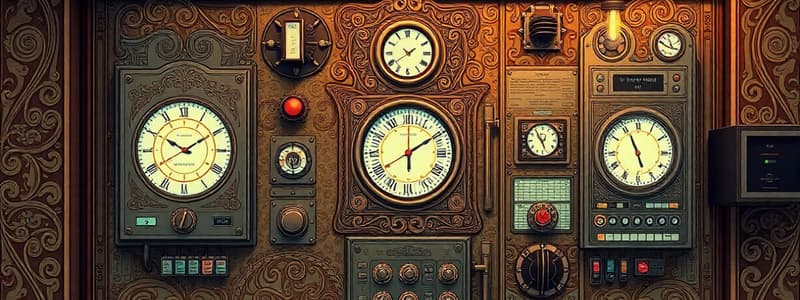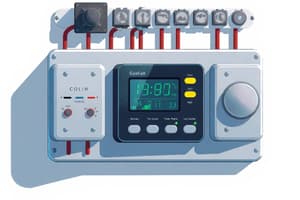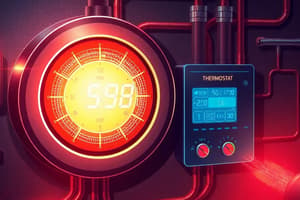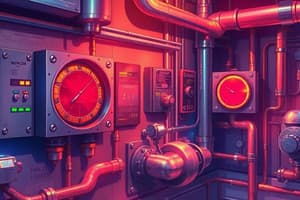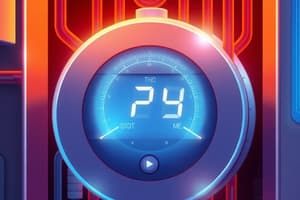Podcast
Questions and Answers
In a VAV box controller, what is the primary function of the damper actuator?
In a VAV box controller, what is the primary function of the damper actuator?
- To control the volume of air entering the space based on the control signal. (correct)
- To control the temperature of the reheat coil.
- To measure the airflow and send the data to the controller.
- To sense the temperature of the air being supplied to the space.
What is the purpose of the reheat coil in a VAV box?
What is the purpose of the reheat coil in a VAV box?
- To increase the temperature of the air supplied to the space when needed. (correct)
- To dehumidify the air supplied to the space.
- To cool the air before it enters the space.
- To filter the air before it enters the space.
Which of the following best describes how automatic controls operate in HVAC systems?
Which of the following best describes how automatic controls operate in HVAC systems?
- They regulate temperature, humidity, and airflow based on user interaction.
- They regulate temperature, humidity, and airflow without user interaction. (correct)
- They require constant manual adjustments to maintain the desired conditions.
- They only protect equipment and do not regulate environmental conditions.
What is the key characteristic of a normally closed (NC) switch?
What is the key characteristic of a normally closed (NC) switch?
In a 'close on rise' control, what happens when the temperature increases?
In a 'close on rise' control, what happens when the temperature increases?
What defines a Direct Acting Control (DAC) system?
What defines a Direct Acting Control (DAC) system?
How does a Reverse Acting Control (RAC) system respond to an increase in the measured variable?
How does a Reverse Acting Control (RAC) system respond to an increase in the measured variable?
Which of the following is an example of an analog signal in HVAC systems?
Which of the following is an example of an analog signal in HVAC systems?
What is a key disadvantage of analog signals in HVAC systems?
What is a key disadvantage of analog signals in HVAC systems?
Which of the following is a characteristic of digital signals?
Which of the following is a characteristic of digital signals?
What is a primary advantage of using digital signals in HVAC systems?
What is a primary advantage of using digital signals in HVAC systems?
Which type of control can cause energy spikes when switching?
Which type of control can cause energy spikes when switching?
Which of the following is an example of automatic electrical control?
Which of the following is an example of automatic electrical control?
Which of the following describes an automatic mechanical control?
Which of the following describes an automatic mechanical control?
What is a characteristic of automatic electromechanical controls?
What is a characteristic of automatic electromechanical controls?
Which of the following is an example of an automatic electronic control?
Which of the following is an example of an automatic electronic control?
What is a key feature of an open loop control system?
What is a key feature of an open loop control system?
Which of the following best describes a closed loop control system?
Which of the following best describes a closed loop control system?
What is the primary characteristic of a Direct Digital Control (DDC) system?
What is the primary characteristic of a Direct Digital Control (DDC) system?
In pneumatic controls, what is used as the signal?
In pneumatic controls, what is used as the signal?
What is the most common type of temperature sensor?
What is the most common type of temperature sensor?
How does an NTC thermistor respond to an increase in temperature?
How does an NTC thermistor respond to an increase in temperature?
What is the function of a flow switch?
What is the function of a flow switch?
What is the purpose of a liquid level switch?
What is the purpose of a liquid level switch?
In what application are combustible gas detectors commonly used?
In what application are combustible gas detectors commonly used?
Flashcards
Automatic Controls in HVAC
Automatic Controls in HVAC
Automatic controls use systems to maintain temperature, humidity, and airflow without manual adjustments.
Normally Closed (NC)
Normally Closed (NC)
At rest, current can pass through the control.
Normally Open (NO)
Normally Open (NO)
At rest, no current passes through the control.
Close on Rise
Close on Rise
Signup and view all the flashcards
Open on Rise
Open on Rise
Signup and view all the flashcards
Direct Acting Control (DAC)
Direct Acting Control (DAC)
Signup and view all the flashcards
Reverse Acting Control (RAC)
Reverse Acting Control (RAC)
Signup and view all the flashcards
Analog Signals
Analog Signals
Signup and view all the flashcards
Digital Signals
Digital Signals
Signup and view all the flashcards
Automatic Electrical Controls
Automatic Electrical Controls
Signup and view all the flashcards
Automatic Mechanical Controls
Automatic Mechanical Controls
Signup and view all the flashcards
Automatic Electromechanical Controls
Automatic Electromechanical Controls
Signup and view all the flashcards
Automatic Electronic Controls
Automatic Electronic Controls
Signup and view all the flashcards
Open Loop System
Open Loop System
Signup and view all the flashcards
Closed Loop System
Closed Loop System
Signup and view all the flashcards
Direct Digital Control (DDC)
Direct Digital Control (DDC)
Signup and view all the flashcards
Pneumatic Controls
Pneumatic Controls
Signup and view all the flashcards
Temperature Sensors
Temperature Sensors
Signup and view all the flashcards
NTC Thermistor
NTC Thermistor
Signup and view all the flashcards
PTC Thermistor
PTC Thermistor
Signup and view all the flashcards
Humidity Sensors
Humidity Sensors
Signup and view all the flashcards
Pressure Transducer
Pressure Transducer
Signup and view all the flashcards
High Pressure Switch
High Pressure Switch
Signup and view all the flashcards
Low Pressure Switch
Low Pressure Switch
Signup and view all the flashcards
Flow Switch
Flow Switch
Signup and view all the flashcards
Study Notes
- Automatic controls in HVAC use control systems to regulate temperature, humidity, airflow and other environmental conditions without user interaction.
- These controls should maintain stable conditions, protect equipment and people, and self-regulate within design boundaries.
Normally Closed Controls
- Current passes through the control at rest.
Normally Open Controls
- Control is open, and current cannot pass through when unpowered.
Close on Rise
- When temperature or pressure increases, the control closes and allows current to pass through.
Open on Rise:
- The control opens and stops current flow when pressure or temperature rises
Direct Acting Control (DAC)
- A control strategy in which an increase in the measured variable (temperature, pressure, humidity) results in a direct increase in controlled output.
- The controlled device responds in the same direction as the change in the sensed condition.
- An increase in output equals an increase in output from the valve/actuator being controlled.
- With 0 VDC output to the actuator, the valve is closed; then the signal changes to 5 VDC and the actuator opens.
- When Inverter output increases to the compressor, cooling also increases.
Reverse Acting Control (RAC)
- A control strategy where an increase in the measured variable (temperature, pressure, humidity) results in a decrease in the controlled output.
- In other words, the controlled device responds in the opposite direction to the change in the sensed condition.
- The output decreases when the input signal increases.
- When duct pressure increases, the fan speed decreases.
Analog Signals in HVAC
- Continuous signals vary over a range of values (e.g., 0-10V or 4-20mA).
- Offer smooth and proportional control.
- Temperature sensors send real-time temperature variations.
- Variable Frequency Drives (VFDs) adjust motor speed for fans and pumps.
- Pressure sensors monitor air or fluid pressure with continuous feedback.
- Humidity sensors provide varying signal based on moisture level.
- Smooth control adjusts equipment gradually, reducing wear and energy spikes and is ideal for variable-speed fans, dampers, and modulating valves.
- Susceptible to noise, as the signal can degrade over long distances.
- Harder to interface with digital systems, requiring Analog-to-Digital Conversion (ADC).
Digital Signals in HVAC
- Binary signals have only two states: ON (1) or OFF (0).
- Used for simple control commands.
- Thermostats turn heating/cooling ON or OFF.
- Fans start or stop airflow.
- Relays and contactors control power to compressors and motors.
- Limit switches detect open/closed positions of dampers and valves.
- Offer reliable and precise operation, with less signal degradation over long distances.
- Easier integration, working seamlessly with microcontrollers and smart HVAC systems.
- Limited control, and provide only gradual adjustments (only ON/OFF).
- Less energy efficient for some applications, since cycling between ON/OFF can cause wear.
Analog vs. Digital Signals in HVAC Comparison
- Analog signals are continuous, while digital signals are binary (ON/OFF).
- Analog signals offer high precision, while digital signals offer lower precision (only two states).
- Analog: modulating controls (variable speed fans, dampers).
- Digital: Simple ON/OFF controls (thermostats, relays).
- Analog: More efficient for gradual changes.
- Digital: Can cause energy spikes when switching.
- Analog signals are more susceptible to interference.
- Digital signals are low (resistant to interference).
- Analog systems require ADC for digital systems.
- Digital systems work directly with smart systems.
Automatic Electrical Controls
- Electrically operated.
- Normally control electrical devices.
- Relays, contactors, motor starters and thermostats.
Automatic Mechanical Controls
- Pressure and Temperature operated
- Control fluid flow.
- Mechanical defrost clocks & mechanical timers.
- Water regulating valve.
Automatic Electromechanical Controls
- Driven by pressure/temperature to provide electrical functions.
- Driven by electricity to control fluid flow.
- Pressure switches.
- Fluid filled temperature bulbs.
- Mechanical thermostat (mercury bulb type).
Automatic Electronic Controls
- It uses electronic circuits to perform the same functions that electrical and electromechanical controls perform such as Controllers, Temperature sensors, and Programmable communicating thermostats
Open Loop Control Systems
- No feedback to adjust systems behavior.
- Control action is independent of the actual output of the system.
- Used when precision is not critical.
Closed Loop Control Systems
- Output is constantly monitored and feedback to the input is provided.
- Allows operation to be adjusted in real time.
- Adjusts for environmental factors, ex. Outdoor air temperature
Direct Digital Control (DDC)
- When digital electronic controls are networked together into a central computer system
- Most popular is BACnet
Pneumatic Controls
- Uses compressed air as the signal.
- Example is 3-15 PSI versus 0-10VDC in an electrical control.
- Is a type of analog control that can be direct or reverse acting.
Temperature Sensors
- Used to sense temperatures.
- Most common type is a thermistor.
- Thermocouples – voltage is created when heated.
- Overloads, Hi-Limits and Thermostats.
NTC thermistor (Negative Temperature Coefficient thermistor)
- A type of temperature sensor whose resistance decreases as temperature increases
- Commonly used in HVAC systems for temperature measurement and control due to its high sensitivity and fast response time.
PTC thermistor (Positive Temperature Coefficient thermistor)
- Is a temperature-sensitive resistor whose resistance increases as temperature increases.
- Commonly used in HVAC systems for overcurrent protection, heating elements, and temperature sensing.
Humidity Sensors
- Measure relative humidity and dew point temperature.
- HRVs use relative humidity sensors and economizers use humidity sensors for dew point.
Sensor/Switch
- Transducer type converts pressure to electrical signal, allowing controller to give a pressure reading.
- High pressure switch opens for high pressure protection.
- Low pressure switch opens for fall of pressure for low pressure protection.
- Air pressure switch can open or close depending on air pressure.
Flow Switch
- Paddle type measures water flow
- Differential flow switch senses differential in air flow
- Piston type airflow moves a piston, which makes or breaks the switch.
Liquid Level Switch
- Float switch, used for water levels in cooling towers and reservoirs.
- Used to determine liquid level in some larger receivers.
- Prevents condensate from breaking cooling if water is not draining.
- Used to determine mix level in food equipment.
Gas Detection Sensor
- Combustible gas detectors for boiler rooms and commercial applications.
- CO detectors for homes and parking garages. They either alert or start ventilation.
- Refrigerant detectors for chiller/mechanical rooms. They alert occupants or shut down equipment.
Studying That Suits You
Use AI to generate personalized quizzes and flashcards to suit your learning preferences.
